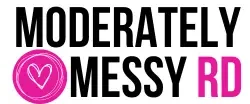This 5-day sample meal plan with 150 grams of protein per day provides a clear picture of what hitting a higher protein goal can look like. Even if you don’t need quite that much, this plan can still serve as inspiration to help you increase your overall daily protein intake.

Protein slows down the digestion of a meal, leaving us feeling fuller for longer while also working to prevent spikes in blood sugar. A higher protein meal increases the chance that you will feel satisfied after eating. Those feelings of fullness and satisfaction can be a game-changer for overall health and weight management.
Even further, protein is what they call the key macronutrient to promote positive changes in body composition. So, yes, protein deserves all the hype it gets. Whether you’re aiming to build muscle, stay fuller longer, or simply lose weight, having an increased awareness of how to reach a higher protein intake can help you with your goals.
But how much protein do you really need? Social media tends to overexaggerate protein needs and consumption – leaving many feeling overwhelmed. How can one eat 150-200 grams of protein per day? The good news: you might not need to!
Let’s go over some of those varying protein recommendations, who should actually be consuming 150 grams per day, with a helpful sample meal plan if you are, in fact, one of those people.
How Much Protein Do We Actually Need?
Ask someone this question and you might get varying answers. If only it were more black and white!
For example the “1 gram per pound” rule that gets thrown around on social media doesn’t account for body composition. Someone who has a higher percentage of lean muscle mass may require more protein than someone of the same weight who is less muscular.
A Summary of Protein Recommendations
For reference: I will use a 250 pound woman who walks 5 days per week and does 2 strength training workouts as well. Divide weight in pounds by 2.2 to get weight in kilograms.
- The RDA, or recommended dietary allowance, is 0.8 grams per kilogram of bodyweight. This is the very minimum amount needed to preserve lean muscle mass. For example, 250/2.2 = 113 x 0.8 = 91 grams of protein.
- The RDA is not really what is considered the “ideal” amount for most healthy, active adults. Most experts, like the International Society of Sports Nutrition, agree that 1.4-2.0 g protein/kg body weight/day is sufficient for most exercising individuals. The higher end would be appropriate for those wanting to build a lot of muscle mass. Equation: 250/2.2 = 113 x 1.4-2.0 = 158-226 grams of protein.
- The one gram per pound of bodyweight refers to lean body mass. So, if you weigh 250 pounds but you are 54% body fat, you would subtract your weight in pounds to get just the lean muscle mass. Equation: 250 x .54 = 135; 250-135 = 115 pounds. Therefore, this amounts to about 115 grams of protein per day – not 250 grams!
So, which recommendation should this person follow? 91 grams is too low for most people in general – especially those who are physically active. The second recommendation is based on international research and the most accurate. So, in this case, I would say 158 grams of protein is most ideal since she is physically active.

Risks of Consuming Too Much Protein
Studies state that excessive protein intake is considered greater than 2 grams of protein per kilogram per day. Eating more than this doesn’t mean you will have kidney problems. However, it can put you at a higher risk for cardiovascular disease if you are consuming too much saturated fat.
The main downfall in consuming too much protein? Well, the risk that you may not be consuming a well-balanced and well-rounded diet.
If you are solely focused on protein – especially if your calorie intake is on the lower side – you might be missing a lot of key macronutrients and micronutrients in your diet.
For example, I saw someone post a 1500 calorie and 170 grams of protein what I eat in a day on TikTok. Yikes! That is about 45% of calories from protein and leaves little room for complex carbohydrates. This may leave you feeling fatigued or low energy.
In terms of macros, 35% of calories from protein maximum is ideal. On a 1500-calorie diet, 100–135g protein is often enough to promote fat loss and preserve lean muscle mass.
Who actually needs 150 grams of protein per day?
- Athletes
- Women with increased protein needs who are pregnant or breastfeeding
- Individuals aiming to build significant muscle mass
- Tall or larger individuals who are physically active. For example, woman who weighs 130 pounds would likely not need 150 pounds of protein per day – even if trying to gain significant muscle mass.
- Certain medical conditions, recovering from surgery, etc.
So, definitely take all this information into account before trying to consume 150 grams of protein. If 120 grams of protein per day seems more realistic, I also have a meal plan for that too!

Consuming a very high protein diet, like 150 grams of protein per day, requires a bit more awareness and meal planning. The above infographic lists some of the best animal and plant-based protein sources.
5-Day 150g protein Meal PLan
While research suggests that evenly distributing protein intake throughout the day can help increase overall intake, there are a few different ways 150 grams per day can be broken down.
Meal and Snack Breakdown
- Three meals with 40 grams of protein + two snacks with 15 grams of protein each.
- Four meals with 35-40 grams of protein.
- Two large meals of 40 grams of protein with three snacks with 23+ grams of protein.
- Three meals with 40 grams of protein + one snack with 30 grams of protein.
I try to list the high protein stars of each recipe so you can understand how to build your own meals. Many of these recipes use cottage cheese and yogurt. I recommend a higher protein plant-based yogurt like Kite Hill for a dairy-free option.
Day 1 Sample Meal Plan
Breakfast (36 Grams of Protein)
Berry Cheesecake Overnight Oats: This is a super easy and delicious cheesecake overnight oats that is prepped in just 5 minutes. These oats use a combination of protein and Greek yogurt to increase the protein content. The chopped nuts on top add some healthy fats with additional protein as well.

Lunch (37 Grams of Protein)
Easy Grilled Chicken Spinach Strawberry Salad (Haute and Healthy Living): This salad features fresh strawberries, feta, avocado, pecans, marinated chicken, and a homemade strawberry balsamic vinaigrette.

Dinner (51 Grams of Protein)
Greek Chicken Protein Bowl: A healthy, high protein and fiber Greek chicken protein bowl with garlic yogurt that feels light and refreshing but is actually very filling! This bowl reminds me of a Mediterranean version of a Chipotle bowl with several components that come together for the ultimate bite!
Protein stars: chickpeas, chicken and garlic yogurt. These three protein sources combined really increase the protein content per serving.

Snacks (26 Grams of Protein Total)
Birthday Cake Cottage Cheese Frozen Bark (13 grams): A birthday cake inspired frozen treat with cottage cheese and protein powder.

2 tablespoons of peanut butter (8g protein) + medium apple + cheese stick (8 grams of protein).
Day 2 Sample Meal Plan {No Protein Powder}
While protein powder adds some convenience to increasing overall protein intake, it is not always necessary. This day focuses on foods without any protein powder.
Breakfast (34.5 Grams of Protein)
Savory Quinoa Breakfast Bake (26.5 grams of protein). This savory breakfast quinoa bake is delicious and packed with protein and fiber to keep you full all morning long! There are eggs, cottage cheese, shredded cheese, and black beans all contributing to the protein content.
It reminds me of a Mexican-inspired frittata with loads of flavor – and it makes for easy leftovers for the week! Pair this with a glass of milk for additional protein (8g per 1 cup).

Lunch (28 Grams of Protein)
Healthy Choice Grilled Chicken and Broccoli Alfredo. This is a high protein frozen meal which can really come in handy when you just don’t have the time or energy to make lunch. For more of my top high protein frozen meal recommendations, read this article.
Dinner (32 Grams of Protein)
Coconut Chicken and Rice Casserole. Because the snacks include beans and cottage cheese already, this dinner is just a simple chicken, rice and veggie one pan casserole. If you have some leftover chicken, this low prep dinner comes together so easily!

Snacks (53 Grams of Protein)
One cup of shelled edamame (18 grams of protein). Seriously, edamame is one of the most nutritious yet high protein snacks! They’re packed with fiber, too.
Cottage Cheese Crisps with Nutritional Yeast (35g protein for entire recipe, about 11 chips). Crispy chips made out of cottage cheese and nutritional yeast. These are so fun and delicious – dip them into whatever you like.

Day 3 Sample Meal Plan
Breakfast (25 Grams of Protein)
S’mores Overnight Oats. Another easy meal prep recipe that is like bringing a campfire to the table. Or, eating dessert for breakfast. These oats use a combination of protein powder and Greek yogurt. Only one scoop of protein powder for 2 servings – which can easily be increased by adding another scoop!
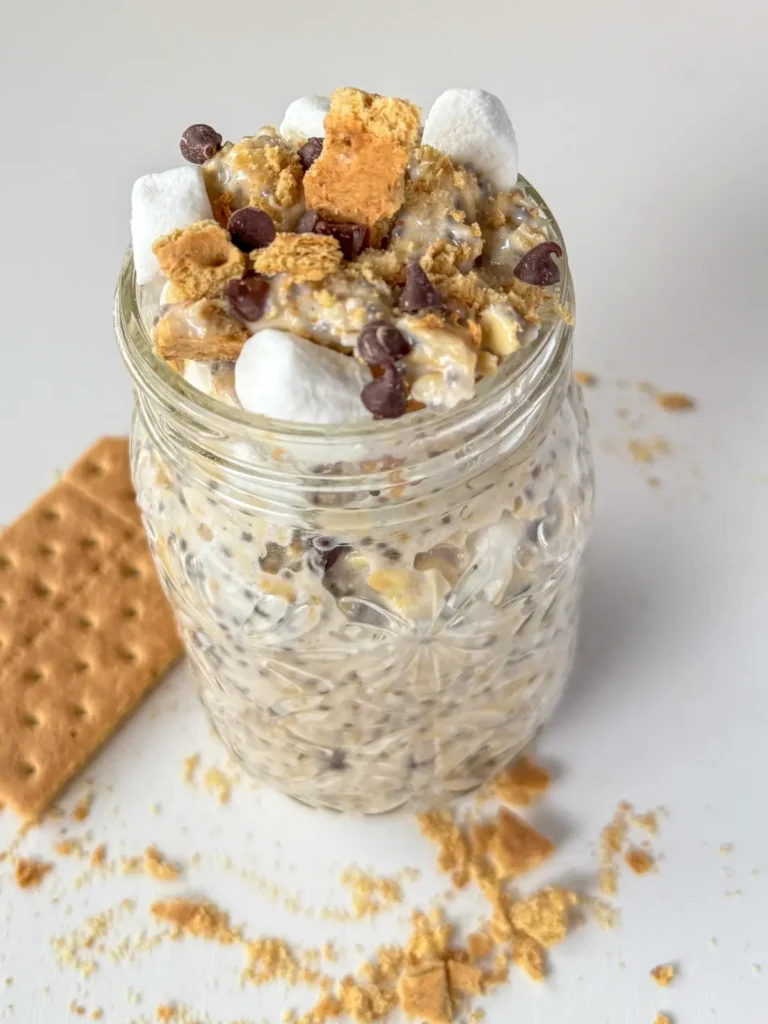
Lunch (30.5 Grams of Protein)
Mediterranean Chicken and Cucumber Salad: The easiest, most delicious throw together meal that’s packed with veggies, protein and fiber! It makes for an easy meal for busy weeknights and a light, refreshing lunch – especially in the summer!

Dinner (48 Grams of Protein)
Buffalo Chicken Crockpot Pasta. Everything is thrown into a crockpot for 6-8 hours – pasta included. The sauce combines a whipped cottage cheese and buffalo sauce to increase the protein. It also uses Barilla Protein Plus Pasta, which provides 10 grams of protein per serving.
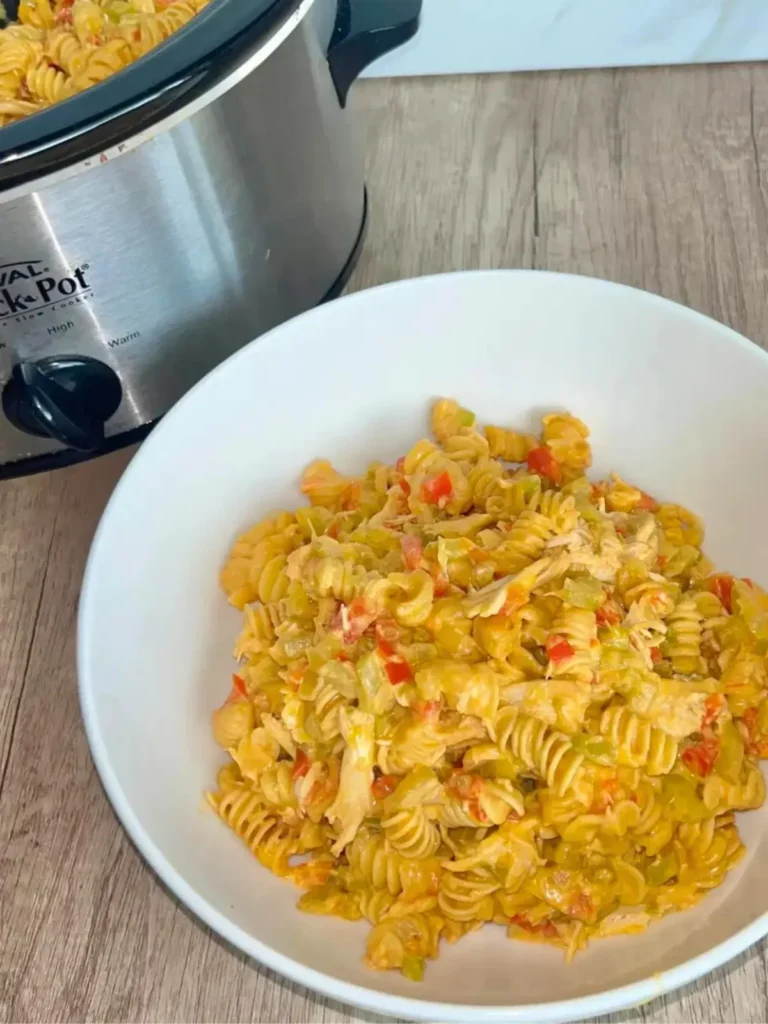
Snacks
1/2 cup of tuna salad with Triscuit crackers (~23g protein total).
Aloha Peanut Butter Cup Protein Bar (14g protein).
Chomps Original Beef Stick (10g protein).
Day 4 Sample Meal Plan
If you aren’t really a breakfast person, this meal plan subs a traditional breakfast with a protein shake. However, there is an additional “meal” or snack at the end of the day.
Breakfast (26 Grams of Protein)
Dark Chocolate Peanut Butter Collagen Smoothie. Peanut butter + chocolate heaven, naturally sweetened with dates. No refined sugars here yet you still get that rich, chocolatey flavor. It’s super simple to make, too – just 6 simple ingredients. Sub with preferred protein powder. This recipe also uses almond milk. If you sub with skim milk, that increases the protein by 8 grams!

Lunch (32 Grams of Protein)
High Protein Lunchable. This simple lunchable is broken down below:
Greek yogurt chicken salad (1/2 cup) with Everything But the Bagel Seasoning (20g protein), 6 100% Whole Grain Triscuit Crackers (3g protein), garbanzo beans, feta, and cucumber salad (6g protein), handful of walnuts (3g protein), and raw veggies.
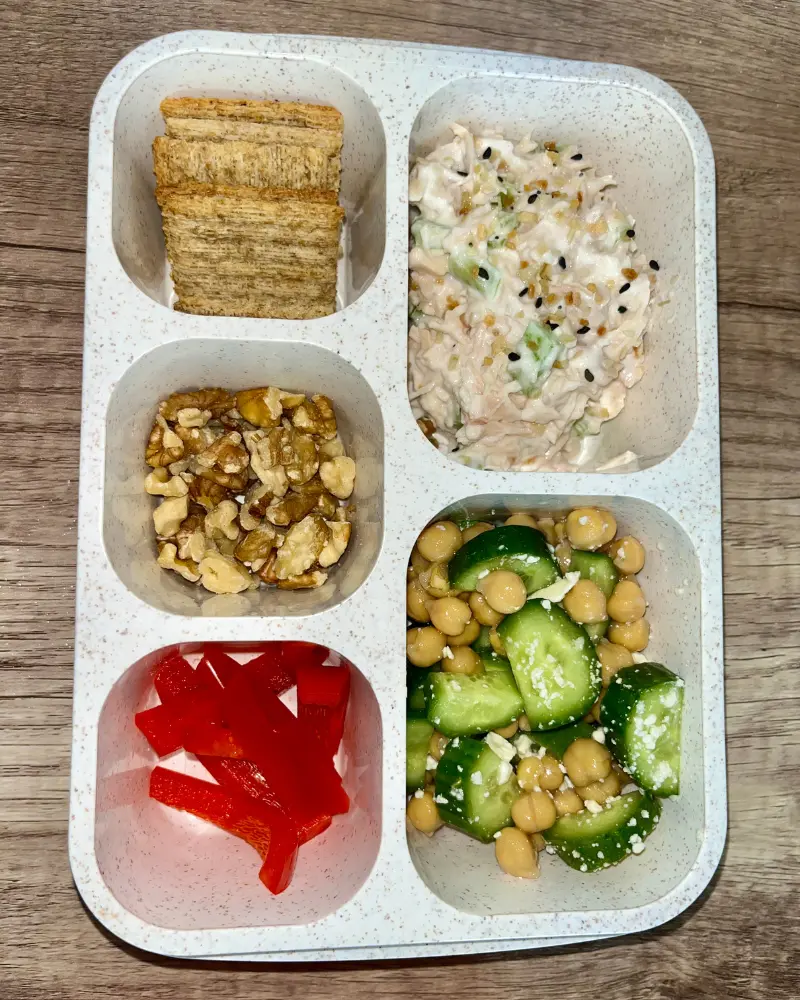
Dinner (40 Grams of Protein)
Viral Turkish Pasta with Sun-Dried Tomatoes and Artichokes: It’s simple, easy, and delicious – especially if you’re a garlic lover! This pasta comes together pretty quickly, even with the various components. It’s like a decadent, creamy pasta but without any cream! The protein stars: ground beef + protein pasta + garlic yogurt sauce.

Additional Meal (40 Grams of Protein)
Arugula and Goat Cheese Cottage Cheese Flatbread. It’s the viral cottage cheese flatbread filled with arugula, cucumbers, feta cheese and a balsamic glaze. The entire wrap has 40 grams of protein without any meat!
Snacks
Birthday Cake Protein Popsicles (13g per popsicle). Birthday cake popsicles with protein powder and yogurt! They’re so good and easy to snack prep. Just store them in the freezer for a refreshing treat.

Day 5 Meal Plan
I am a big believer that if you want to reach a higher protein intake then a high protein breakfast should be prioritized. It just makes the rest of the day so much easier! Check out my post on 30 Breakfasts with 30+ Grams of Protein for more ideas.
Breakfast (45 Grams of Protein)
High Protein Kodiak Cake Waffles from The Sweet Simple Things (31g protein) + 1/2 cup of vanilla Greek yogurt (14g protein) on top with maple syrup.
Lunch (36 Grams of Protein)
High Protein Chickpea Quinoa Salad (Cooking for Peanuts). This mason jar salad meal prep is a vegetarian option with chickpeas, hemp seeds/hearts and quinoa increasing the protein content.
Dinner (37 Grams of Protein)
Sheet Pan Salmon and Asparagus (Get Inspired Everyday!), 37grams of protein. An easy sheet pan roasted salmon with asparagus.

Snack (30 Grams of Protein)
Chia Seed Pudding with Protein Powder, 20 grams of protein. A creamy, nutritious pudding that is high in both protein AND fiber.
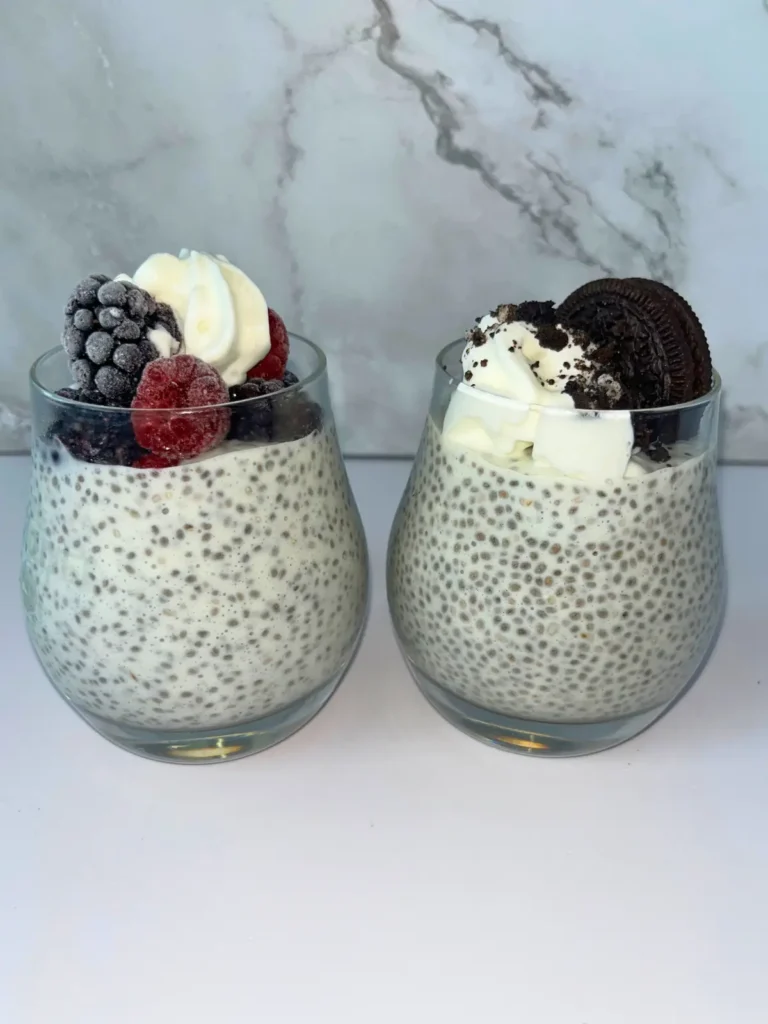
The Only Bean Roasted Edamame Beans (10g protein). Another healthy snack option with a good balance of both protein and fiber. Roasting chickpeas in the oven with preferred seasonings is also a great option! 1/2 cup has about 8 grams of protein.
Don’t Forget About Fiber
Fiber is an underrated nutrient that, like protein, assists with meal satiety and satisfaction. On top of the weight management benefits, fiber improves the gut microbiome, reduces cholesterol, lowers risk of cardiovascular disease and certain cancers.
This website has many resources dedicated to helping others increase their protein and fiber intake. Feel free to follow along!
